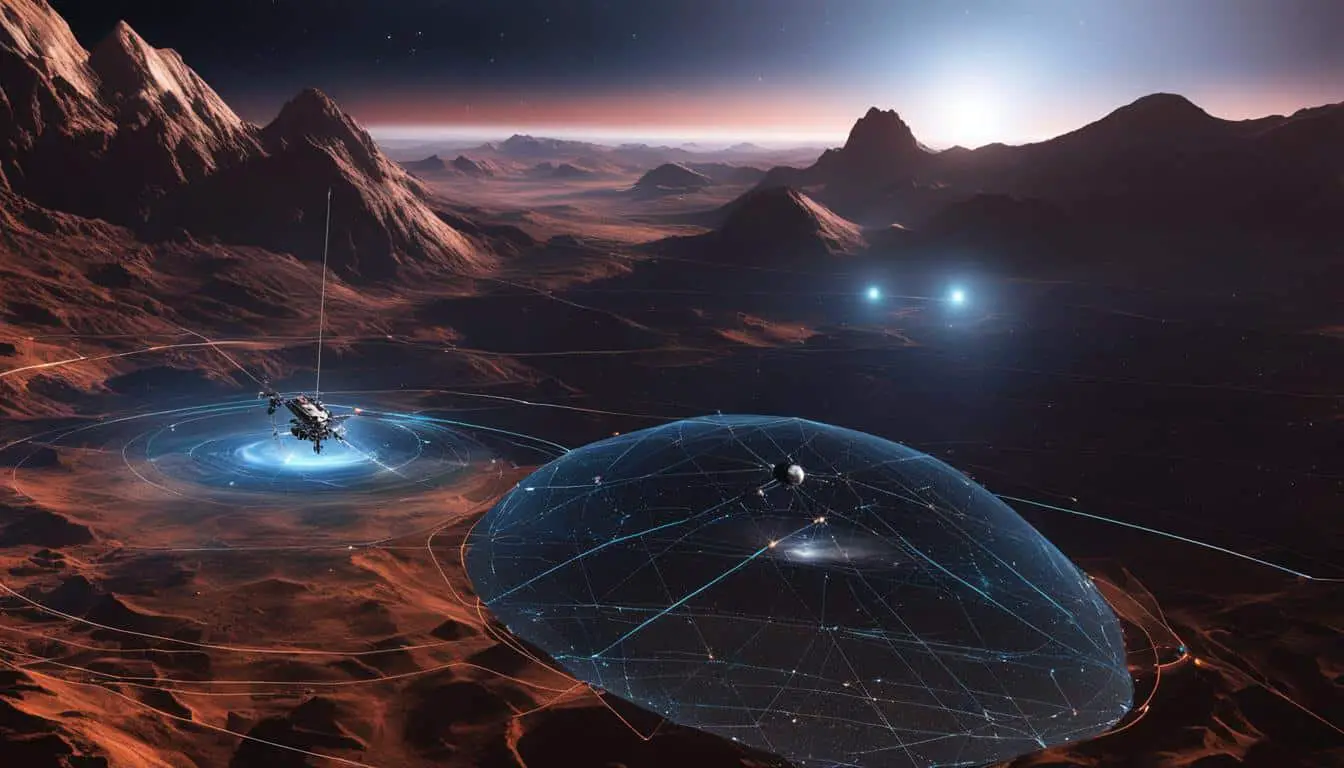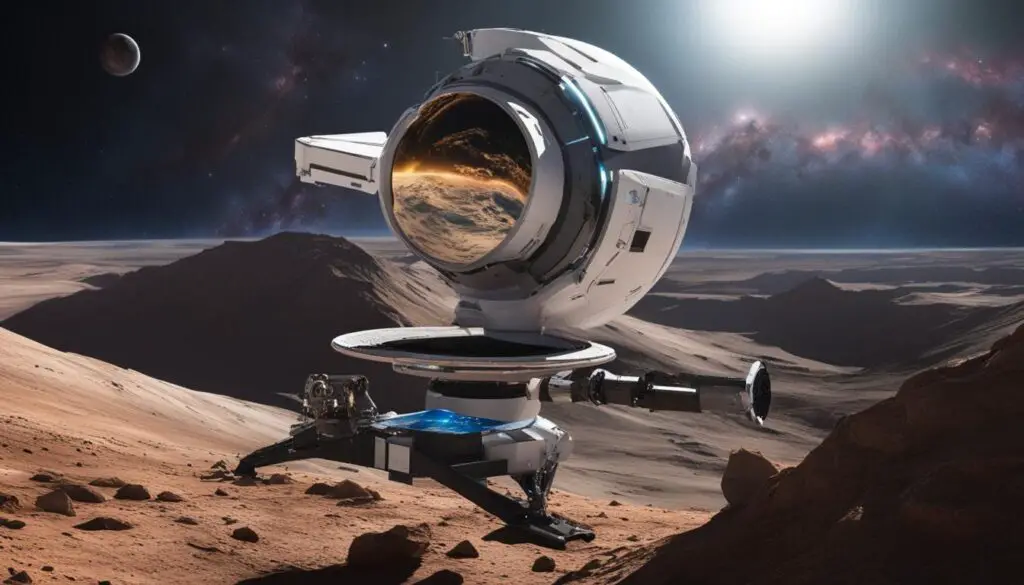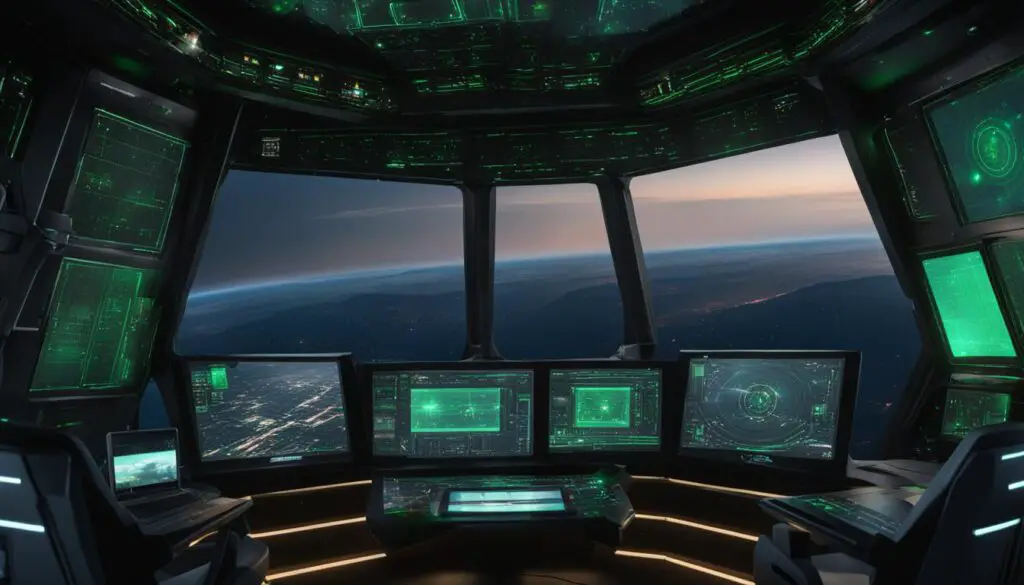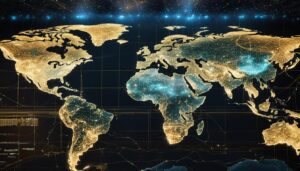
Artificial intelligence (AI) is revolutionizing the field of space exploration, particularly in the area of data analysis. As the volume of data collected from satellites, telescopes, and probes continues to grow exponentially, AI algorithms have become crucial in processing and analyzing this massive amount of information. From classifying celestial objects to identifying exoplanets and analyzing spectral data, AI-powered systems are transforming our understanding of the cosmos.
Key Takeaways:
- AI has revolutionized space exploration by automating data analysis
- AI algorithms enable the processing and analysis of massive amounts of space data
- AI-powered systems contribute to the classification of celestial objects and identification of exoplanets
- Space data analysis using AI has transformed our understanding of the cosmos
- AI in space exploration holds the potential for further discoveries and advancements
Enhancing Autonomous Robotic Systems for Space Exploration
AI is not only revolutionizing data analysis in space exploration but also enhancing the autonomy of robotic systems. By leveraging AI algorithms, autonomous robotic rovers like NASA’s Curiosity and Perseverance are able to navigate planetary surfaces, detect obstacles, and prioritize scientific targets with unprecedented accuracy and efficiency. These AI-powered systems enable the rovers to adapt to changing terrain conditions and make real-time decisions, without the need for constant human intervention.
One key area where AI has greatly improved robotic systems is in the field of entry, descent, and landing (EDL). AI algorithms have made it possible for probes to achieve higher precision in reaching designated landing zones. By analyzing data from various sensors and making real-time adjustments, AI-powered EDL systems can ensure a safer and more accurate landing, even in challenging environments.
The advancements in AI have also led to significant improvements in the ability of robotic systems to perform scientific tasks. For example, AI-powered algorithms help robotic systems identify and prioritize scientific targets for investigation, allowing for more efficient use of time and resources. These systems can also adapt to unexpected discoveries, altering their mission plans on the fly to maximize scientific output.
Table: Enhancements in Autonomous Robotic Systems for Space Exploration
| Area of Enhancement | Description |
|---|---|
| Autonomous Navigation | AI algorithms enable rovers to navigate planetary surfaces, detect obstacles, and make real-time decisions without the need for human intervention. |
| Entry, Descent, and Landing (EDL) | AI algorithms improve the accuracy of EDL systems, allowing probes to reach designated landing zones with higher precision. |
| Scientific Target Prioritization | AI-powered systems help identify and prioritize scientific targets for investigation, optimizing the use of time and resources. |

AI is truly revolutionizing space exploration by enhancing the autonomy and capabilities of robotic systems. With ongoing advancements in AI technology, we can expect even more significant breakthroughs in the future. By combining the power of AI with human ingenuity, we are expanding our understanding of the universe and pushing the boundaries of what is possible in space exploration.
Supporting Astronaut Health with AI
Artificial intelligence (AI) is revolutionizing space exploration in various ways, and one of its significant contributions is in supporting astronaut health. With the help of predictive health analytics powered by AI, multi-modal data streams related to astronauts’ well-being can be integrated and analyzed to provide personalized interventions and early risk warnings.
These AI-powered systems can monitor vital signs such as heart rate, temperature, exercise patterns, and sleep data, enabling healthcare professionals to gain valuable insights into astronauts’ health conditions. By leveraging AI algorithms, anomalies or potential health risks can be identified more efficiently, allowing for timely interventions. This technology plays a crucial role in ensuring astronauts’ well-being during long-duration missions, where access to medical facilities is limited.
Furthermore, AI systems also provide psychological support to astronauts during their space missions. An example of such a system is the Crew Interactive Mobile Companion (CIMON). By acting as a companion, CIMON assists astronauts with various tasks, including navigation, documentation, and experiments. Additionally, CIMON offers emotional support, which is especially valuable during extended periods of isolation and stress.

As AI continues to evolve, the possibilities for improving astronaut health and well-being are endless. By leveraging advanced analytics and machine learning algorithms, AI can provide astronauts with personalized and proactive healthcare. This not only ensures their physical well-being but also helps them maintain mental and emotional balance throughout their space missions.
Conclusion
In conclusion, the integration of AI in space exploration has revolutionized the field, providing significant advancements in data analysis, autonomous robotic systems, and astronaut health support.
By automating data analysis, AI algorithms have accelerated the processing and analysis of vast amounts of space data, enabling scientists to focus on interpreting the results and uncovering new mysteries of the universe.
The enhanced autonomy of robotic systems, powered by AI, has led to remarkable achievements in space exploration. From navigating planetary surfaces to landing probes with higher precision, AI has enabled robotic rovers and probes to adapt to changing conditions and make real-time decisions independently.
Furthermore, AI is supporting astronaut health by integrating multi-modal data streams and providing personalized interventions and early risk warnings. AI-powered systems like the Crew Interactive Mobile Companion (CIMON) act as invaluable companions for astronauts, offering emotional support and assisting with various tasks, enhancing their overall well-being during long-duration missions.
The future of AI in space exploration is promising, with further breakthroughs and discoveries on the horizon. The continued advancements in AI technology will undoubtedly expand our understanding of the universe and pave the way for the exploration of distant planets and celestial bodies.
FAQ
How is AI used in space exploration?
AI is used in space exploration for automating data analysis, enhancing autonomous robotic systems, and supporting astronaut health.
What role does AI play in data analysis for space exploration?
AI algorithms are crucial in processing and analyzing the massive amount of data collected from satellites, telescopes, and probes, enabling scientists to discover and interpret insights about the cosmos.
How does AI enhance the autonomy of robotic systems in space exploration?
AI algorithms enable robotic systems, such as NASA’s Curiosity and Perseverance rovers, to navigate planetary surfaces, detect obstacles, and make real-time decisions without human intervention, improving their adaptability and efficiency.
How does AI support astronaut health in space?
AI-powered systems integrate multi-modal data streams to provide personalized interventions and early risk warnings for astronauts. AI companions, like the Crew Interactive Mobile Companion (CIMON), also assist astronauts with tasks and provide emotional support during long-duration missions.
What impact does AI have on space exploration?
AI revolutionizes space exploration by accelerating data analysis, improving robotic systems’ autonomy, supporting astronaut health, and expanding our understanding of the universe and distant planets.
Source Links
- https://www.azoquantum.com/Article.aspx?ArticleID=474
- https://www.linkedin.com/pulse/ai-space-exploration-how-advancing-our-understanding
- https://www.forbes.com/sites/bernardmarr/2023/04/10/artificial-intelligence-in-space-the-amazing-ways-machine-learning-is-helping-to-unravel-the-mysteries-of-the-universe/?sh=2666748f7b60








